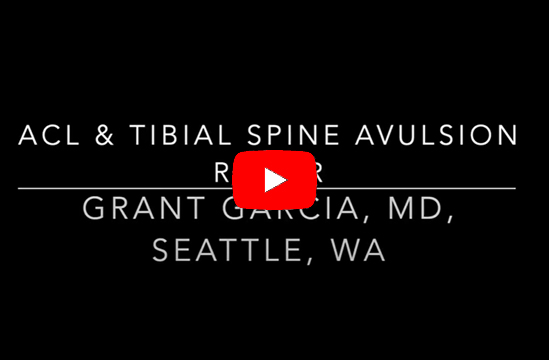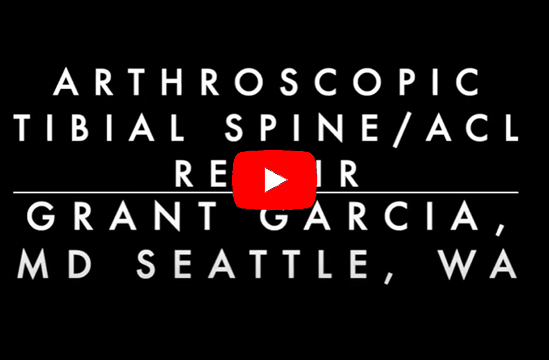Pediatric Tibial Spine Avulsions
Dr. Garcia’s newest technique to fix ACL tibial spine using the new ACL tightrope system
Overview
- a tibial eminence fracture, also known as a tibial spine fracture, is an intra-articular fracture of the bony attachment of the ACL on the tibia that is most commonly seen in children from age 8 to 14 years during athletic activity
- treatment is closed reduction and casting or open reduction and fixation depending on the degree of displacement and whether it can be reduced
Epidemiology
- incidence
- 2-5% of knee injuries with effusion in the pediatric population
- demographics
- most common in ages 8-14
Pathophysiology
- traumatic mechanism
- rapid deceleration or hyperextension/rotation of the knee, as in sports
- same mechanism that would cause ACL tear in adult
- fall from bike or motorcycle (typically resulting in hyperextension)
Associated conditions
- occur in 40% of eminence fractures
- meniscal injury
- collateral ligament injury
- capsular damage
- osteochondral fracture
Prognosis
- overall prognosis is good with 85% returning to prior level of sport
Anatomy
Osteology
- tibial eminence
- non-articular portion of the tibia between the medial and lateral tibial plateau
- Consists of two spines: ACL attaches to medial spine
- ACL insertion is 9mm posterior to the intermeniscal ligament and adjacent to anterior horns of meniscus
- PCL does not attach to tibia spines
- Pediatric specific
- Intercondylar eminence in incompletely ossified and is more prone to failure than ligamentous structures
- Failure occurs through deep cancellous bone
- Fracture usually confined to intercondylar eminence, but it may propagate to tibial plateau, medial is most common
Ligaments
- anterior cruciate ligament inserts 10-14 mm behind anterior border of tibia and extends to medial and lateral tibial eminence
Presentations
Symptoms
- severe swelling and pain in the knee
- inability to bear weight
Physical exam
- inspection
- immediate knee effusion due to hemarthrosis
- Knee usually in flexed position
- ROM
- often limited secondary to pain
- once pain is controlled, lack of motion may indicate
- meniscal pathology
- displaced/entrapped fracture fragment positive anterior drawer
Imaging
Radiographs
- recommended views
- AP
- lateral
- most useful for determining fracture displacement
- intercondylar
- oblique
- helpful in determining the extent of tibial plateau involvement
CT
- useful for pre-operative planning
- used when fracture displacement cannot be determined by plain radiographs
MRI
- better at determining associated ligamentous/meniscal damage than CT or radiographs
- Majority of fractures show no additional internal derangement (meniscus injuries)
- 15-37% of cases have associated intra-articular pathology
Treatment
Non-operative
Dr. Garcia demonstrates his all suture technique for ACL repair and ACL tibial spine repair.
- closed reduction, aspiration of hemarthrosis, immobilization in full extension
- indications
- non-displaced type I and reducible type II fractures
- reduction technique
- see techniques below
- immobilization
- cast in extension for 3-4 weeks
- patients get extremely stiff with prolonged immobilization
- allows for gradual rehab program
- cast in extension for 3-4 weeks
- indications
Operative
- ORIF vs. all-arthroscopic fixation
- indications
- Type III or Type II fractures that cannot be reduced
- type II fractures may fail to reduce due to the entrapped medial meniscus, entrapped intermeniscal ligament, or the pull of the lateral meniscus attachment block to extension
- Type III or Type II fractures that cannot be reduced
- indications




















